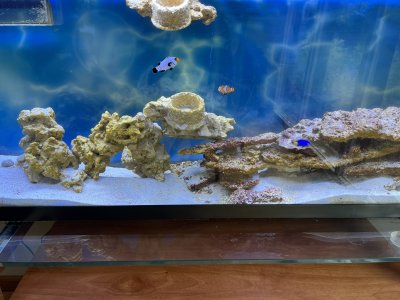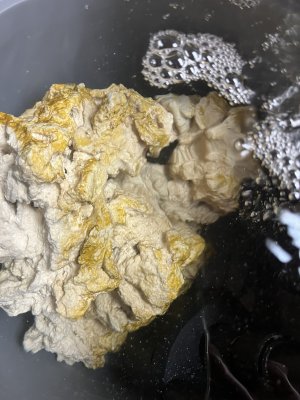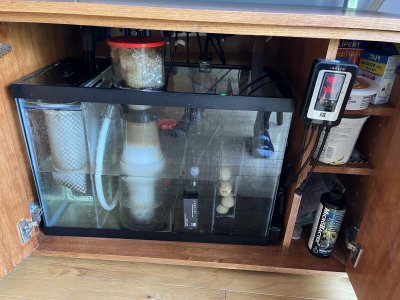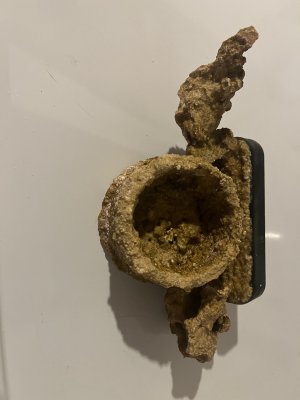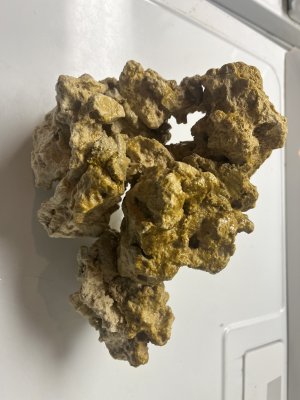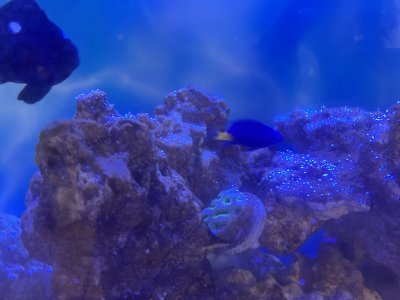I think I have a Cyanobacteria problem. See pics. I have been heating the rock in the second pic at 88 degrees for about 4 hours. Only some has been removed. It is a 55 g tank with 4 healthy fish ( not being over fed), no coral. Treated with ChemiClean about a week ago. Phosphate measured at 0.1ppm. Any suggestions are appreciated!
You are using an out of date browser. It may not display this or other websites correctly.
You should upgrade or use an alternative browser.
You should upgrade or use an alternative browser.
New with Cyanobacteria
- Thread starter Cdentata
- Start date
I read that yellow is a sign of it dying, but I have no idea. I never saw yellow. Mine was red, far thicker than that, and when it died/disappeared it just vanished. so I never had the yellowing. if it was me, with a fish only tank, I'd probably manually scrub the rocks a bit personally. I don't remember the protocol on chemiclean as it's been a while but I thought when I did it, it recommended 2 doses in a week and a water change?
whatever you have going in there doesn't look that bad to me and it sounds like you're being smart addressing it early. curious to see what the others have to say. seems like I fight a diferent type of algae about twice a year and each time I seem to cut it off faster and faster as I learn.
whatever you have going in there doesn't look that bad to me and it sounds like you're being smart addressing it early. curious to see what the others have to say. seems like I fight a diferent type of algae about twice a year and each time I seem to cut it off faster and faster as I learn.
To me, the second picture looks more like diatoms. The Cyano we typically see in this hobby is red to maroon in color and forms fairly thick mats on the rock and sand.
How long has the tank been setup?
What filtration are you using?
Are you running any type media such as carbon or GFO?
Your Phosphate levels are a bit high. What are your other water parameters:
Are you running the tank temp at 88 or is that in a separate container of some sort? The generally accepted range for a reef tank is 76-80 degrees F.
Here's a handy reference chart for the most commonly tested water parameters for a reef tank.

How long has the tank been setup?
What filtration are you using?
Are you running any type media such as carbon or GFO?
Your Phosphate levels are a bit high. What are your other water parameters:
- Ammonia
- Nitrite
- Nitrate
- Alkalinity
- Calcium
- Magnesium
- pH
Are you running the tank temp at 88 or is that in a separate container of some sort? The generally accepted range for a reef tank is 76-80 degrees F.
Here's a handy reference chart for the most commonly tested water parameters for a reef tank.
The Cyano we typically see in this hobby is red to maroon in color and forms fairly thick mats on the rock and sand.
that was my experience. After the chemiclean later, like a year later, I used Slime Out, but so far (knock on wood) I haven't had a 3peat
The tank has been setup for almost 3 years. Under gravel filtration for about a year, then added a sump to add coral. My water is RODI. The sump has filter socks, skimmer, MarinePure beads and return pump. I had not thought about diatoms. A couple more pics below. Maybe I just need to beef up my cleanup crew. I am thinking Astrea and Cerith snails, some hermit crabs.
Attachments
Honestly, it doesn't look too bad, IMO. And, it sounds like you've got your system setup correctly. The only thing I'd question (and I'm not saying you need to remove them) is the MarinePure beads. IMO, with live rock, sand, skimmer and filter sock I don't think those are necessary.The tank has been setup for almost 3 years. Under gravel filtration for about a year, then added a sump to add coral. My water is RODI. The sump has filter socks, skimmer, MarinePure beads and return pump. I had not thought about diatoms. A couple more pics below. Maybe I just need to beef up my cleanup crew. I am thinking Astrea and Cerith snails, some hermit crabs.
Since you just joined RC yesterday, I was wondering if it was a newly setup tank. But, since that's not the case, there's something off in your water parameters. I'd still be curious to know what your other water parameters (asked in my post above) are as this just started after running fine for three years. Although, since this is not a new tank, I'm not concerned about the ammonia and nitrite but, I'm curious what your nitrates are.
We already know your phosphate is a little high and I'd be willing to bet nitrates are a bit high as well. Doing regular water changes and adding GFO should help. Nitrates and phosphates feed algae growth.
Beefing up your CUC should help, especially Ceriths. But, that will only be putting a bandaid on whatever is causing it. If we could figure out what's suddenly causing the growth you could reduce the need for additional cleaners.
Since you stated you plan to add corals, you'll definitely want to make sure those parameters (nitrate, phosphate, alkalinity, calcium and magnesium) are in line with the chart I posted.
What test kits are you using? I personally prefer Salifert test kits and Hanna checkers for their easy of use and being fairly accurate (for hobby grade test kits.
Hanna checkers for their easy of use and being fairly accurate (for hobby grade test kits.
I'm starting to dream of Hanna checkers, they look like an awesome solution...
Thanks for your quick replies and reminder to test all parameters:
pH 8.3
PO4 0.1
Ca 400
Mg 1200
Nitrate 0 (since Phosphate is high, might check this to confirm)
Nitrite 0 ((API)
Ammonia 0
Alkalinity 9.3
Salinity (refractomer)
All others are Salifert and am planning to buy some Hanna checkers.
I have always had uncertainty about how test parameters relate to or effected by the biological activity in the tank. If parameters look good, what else can explain what I am seeing? Along with more clean-up crew, would GFO be a good addition? Could GFO be added to the chamber after the skimmer?
pH 8.3
PO4 0.1
Ca 400
Mg 1200
Nitrate 0 (since Phosphate is high, might check this to confirm)
Nitrite 0 ((API)
Ammonia 0
Alkalinity 9.3
Salinity (refractomer)
All others are Salifert and am planning to buy some Hanna checkers.
I have always had uncertainty about how test parameters relate to or effected by the biological activity in the tank. If parameters look good, what else can explain what I am seeing? Along with more clean-up crew, would GFO be a good addition? Could GFO be added to the chamber after the skimmer?
Long winded response to follow.Thanks for your quick replies and reminder to test all parameters:
pH 8.3
PO4 0.1
Ca 400
Mg 1200
Nitrate 0 (since Phosphate is high, might check this to confirm)
Nitrite 0 ((API)
Ammonia 0
Alkalinity 9.3
Salinity (refractomer)
All others are Salifert and am planning to buy some Hanna checkers.
I have always had uncertainty about how test parameters relate to or effected by the biological activity in the tank. If parameters look good, what else can explain what I am seeing? Along with more clean-up crew, would GFO be a good addition? Could GFO be added to the chamber after the skimmer?
My answers below are assuming you are going to add corals/other inverts (beside the CUC) sooner rather than later
Overall, I think you're doing a great job. Even those of us who have been in the hobby a long time (I've been in over 40 years) deal with algae issues from time to time. Just two years ago, I had the worst outbreak of cyano I've ever had. If you're curious about all the things I tried, here's the thread on that battle. It was not fun.
Your ammonia, nitrite, alkalinity, pH and calcium all look good. Magnesium and nitrate are a bit low. As mentioned before, phosphate is a bit high.
Alkalinity is just a tad low, I personally shoot for 10 and generally keep my magnesium at 1300.
Phosphate should be in the 0.01 - 0.03 ppm range. You can lower phosphate by putting GFO in either a media bag in the sump or set up a media reactor. The media reactors are much more effective than just putting the GFO is a bag in the sump as they force the water through the GFO.
We no longer try to achieve zero nitrate for reef tanks. The recommended reading is 1-10 ppm. I actually add about 2ml of nitrate daily to my 40 gallon tank to maintain those levels. But, I would double check your nitrate levels with a different test kit before adding nitrate to the tank in case your test kit is bad.
While I think you have diatoms, I'm not 100% certain. @kharmaguru @Reefing102 any thoughts here?
If it is diatoms, here's a great article by @ReefBum on how to eliminate and prevent diatoms. From the article, "Diatoms feed mainly off of silicates but also consume dissolved organic compounds, phosphate and nitrates."
Do you test the TDS of your post RODI water? If so, what is the reading? If zero, we can assume silicates are not the issue. So, it must be either the nitrates and/or phosphates. You could be showing zero nitrates because the diatoms are consuming it.
Disclaimer: There is no single correct way to successfully keep a reef/marine tank. What may work perfectly for one person may by an utter failure for another.
That said, here is what I would do. Weekly water changes in the 10-20% range siphoning out as much of the diatoms when doing so. Add GFO either via a media bag or reactor. Be patient, nothing good happens fast in this hobby.
I’m not really seeing Cyano either. Is the rock new to the tank? Looks pretty new for being 3 years old. My guess is it’s just the rock maturing.
Thanks for all comments. I appreciate the variety of ideas/ thoughts to apply to my situation. Yeah, I have held off buying coral because of the algae, etc. So, maybe I should just go ahead. Would Ricordea mushroom and Frogspawn corals be “safe” to add? My reading is that they are fairly easy to care for and generally tolerant.
The rock on the left has been in the tank for almost 3 years and on the right about 18 months.
The tank temp is held at 78. My 5-stage RODI has a TDS meter and I check that it is 0.
Flow has also been mentioned as a possibility. I have been maintaining a flow of ~ 2000GPH but I think I haVE dead spots because I see more algae on the glass in places. I saw one suggestion to stir up some sand and see where it goes.
The rock on the left has been in the tank for almost 3 years and on the right about 18 months.
The tank temp is held at 78. My 5-stage RODI has a TDS meter and I check that it is 0.
Flow has also been mentioned as a possibility. I have been maintaining a flow of ~ 2000GPH but I think I haVE dead spots because I see more algae on the glass in places. I saw one suggestion to stir up some sand and see where it goes.
Ricordea like a bit of "dirtier" water. Mine really perked up and started splitting when I started adding nitrate. So, with your zero nitrate, they may not thrive as well. I won't comment on the Frogspawn because it's been over 20 years since I've tried to keep an LPS coral so my knowledge of them is a bit outdated.
Question about the 18 month old rock. Where did you get the rock from? Some rock (I don't recall from which vendor/source) is known to leach phosphates.
Lastly, you have 2000 gph flow. Is that from the return pump, powerhead(s) or both?
Question about the 18 month old rock. Where did you get the rock from? Some rock (I don't recall from which vendor/source) is known to leach phosphates.
Lastly, you have 2000 gph flow. Is that from the return pump, powerhead(s) or both?
While I have not used Real Reef personally, I've not heard any bad things about it but, I've never researched it either. Since the shutdown of Indo-Pacific live rock way back when, I've only used a combination of dry rock and Florida Keys aquacultured rock.The red rock is Real Reef Shelf rock. Please let me know if you know anything about it. I just ordered a Brightwell Aquatics Nitrogen supplement which I’ll add to hit the desired Nitrate range.
It's possible you've got dead spots but, I wouldn't attribute the diatoms solely to that as they need nutrients (the silicates, nitrates and phosphates) to survive. Increasing your flow rate certainly couldn't hurt as long as it's tolerable for the fish. I personally prefer having two powerheads/wavemakers at opposite ends of the tank and alternating flow. But, I do that because my favorite corals are Acropora which needs a lot of flow.Oh, forget about my pumps. The return pump is at one end with a flow of around 700. I just added a Nero3 wave maker, which is at the left end with the remainder of the flow but which can be bumped up further%
ETA - I mentioned I'm cheap. I've never owned a Nero, I use Jebao powerheads/wavemakers. They're much less expensive and I've had good experience with them over the years. If you're on a budget, check them out.
My frogspawn grew fast for a year from one head to about five. He's 3 years old with me now and still about five heads. I'm not sure why he's not "happy". He's not dying, but I think he needs more flow.
I took a very small hammer I bought recently and moved him to my nano tank (4g) and right under direct flow. Suddenly he's doubling in size.
My frogspawn was always very easy but I think what he's lacking in my bigger tank is more direct flow. But again big or small, I've had him for three years.
I took a very small hammer I bought recently and moved him to my nano tank (4g) and right under direct flow. Suddenly he's doubling in size.
My frogspawn was always very easy but I think what he's lacking in my bigger tank is more direct flow. But again big or small, I've had him for three years.
I agree.While I think you have diatoms, I'm not 100% certain. @kharmaguru @Reefing102 any thoughts here?
Similar threads
- Replies
- 3
- Views
- 1K

